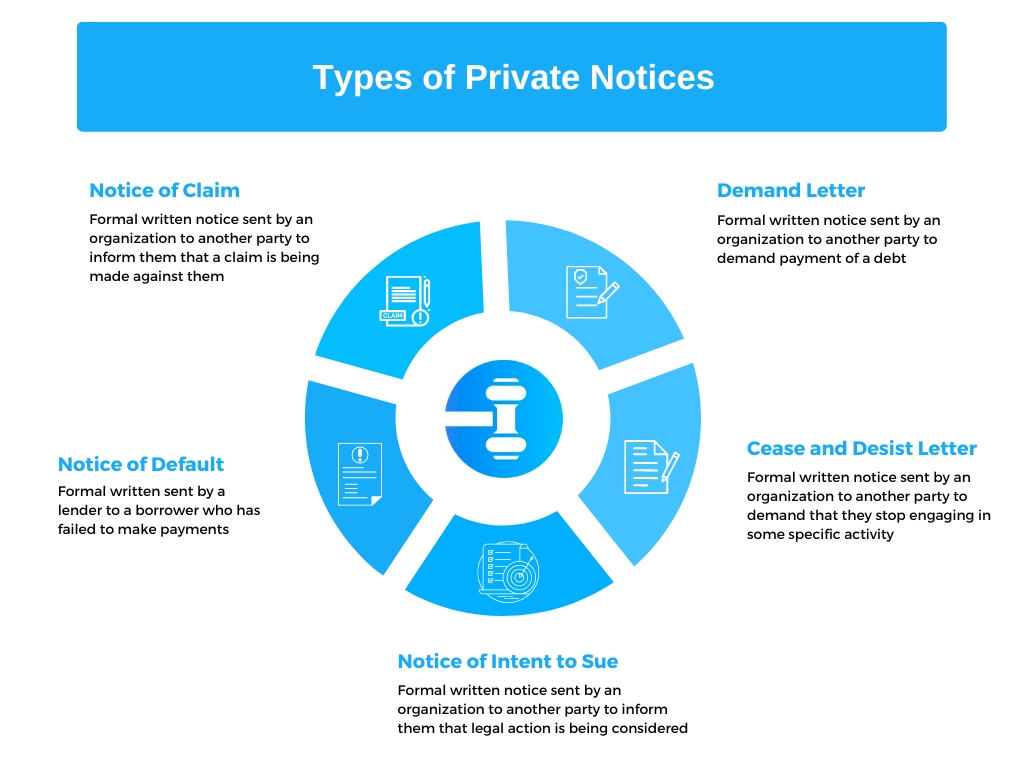Private Notices- Examples and Citations
Private notices are a type of legal notice that is issued by a private individual or organization, as opposed to a government agency. They are typically used to provide notice of a legal action or claim, such as a lawsuit or debt collection. In this article, we will discuss private notices, provide examples of common types of private notices, and discuss how to cite private notices in legal documents properly.
What are Private Notices
A private notice is a formal written communication sent from one individual or organization to another. It is typically used for personal and confidential information not intended for public dissemination. Private notices can be used for various purposes, such as to provide information about a legal dispute, to request payment of a debt, or to provide notice of a change in terms of a contract. They are often used when a more formal or official method of communication is required. The recipient of a private notice is typically expected to take some action in response to the information, such as making a payment or providing a written response.
Types of Private Notices

Notice of Default or Foreclosure
A Notice of Default or Foreclosure is a formal written notice typically sent by a lender to a borrower who has failed to make payments on a mortgage loan. The message informs the borrower that they are in default and that the lender may begin foreclosure proceedings if the default is not cured within a certain period. The message typically includes the following information:
- The amount of the unpaid mortgage payments and any late fees accumulated.
- The date by which the borrower must cure the default, typically 30-90 days, otherwise, the lender may proceed with the foreclosure process.
- A description of the property that is subject to foreclosure.
- The name and contact information of the lender or their representative who can provide more information about the foreclosure process.
- A warning that if the borrower fails to cure the default, the lender may take steps to take possession of the property and sell it to recoup the outstanding mortgage debt.
It is important to note that laws regarding foreclosure vary by state, and the procedure may be different depending on the jurisdiction. In some cases, a borrower may have the right to request a loan modification or mediation with the lender, and the notice should inform about these options as well.
The borrower needs to take immediate action once they receive a Notice of Default or Foreclosure, as it may affect their credit score and their ability to purchase or rent property in the future.
Demand Letter
A Demand Letter is a formal written notice that is typically sent by an individual or organization to another party to demand payment of a debt or to request that some other actions be taken. The letter typically sets out the details of the debt or action that is being demanded, and may also include a deadline for compliance. The letter typically includes the following information:
- A clear and specific demand for payment or action, such as the amount of money owed, or the specific action that is being requested.
- The reason for the demand, such as the outstanding debt or breach of contract.
- A deadline for compliance, such as a date by which the debt must be paid or the requested action must be taken.
- A warning that legal action may be taken if the demand is not met.
- The contact information of the sender, such as their name, address, and telephone number.
- The evidence that supports the demand, such as invoices, contracts, receipts, or other documents.
It’s important to note that demand letters are not legally binding and are typically used as a way to resolve disputes before going to court. They are used as a tool to put the recipient on notice of the claim and allow them to resolve the matter before a lawsuit is filed. The recipient needs to read the letter carefully and respond to it within the specified deadline or seek legal advice if they are unsure of their rights or obligations.

Cease and Desist Letter
A Cease and Desist Letter is a formal written notice that an individual or organization typically sends to another party to demand that they stop engaging in some specific activity that is deemed to be illegal, unethical, or in violation of a contract. This type of letter is often used to stop activities such as:
- Copyright infringement
- Trademark infringement
- Defamation
- Harassment
- Invasion of privacy
- Unauthorized use of a name or likeness
- Violation of a non-compete or non-disclosure agreement
- Unfair competition
The letter typically includes the following information:
- A clear and specific statement of the activity that must be stopped, including any relevant details such as dates and locations.
- A citation of the legal authority that prohibits the activity (e.g. the statute, regulation, or court decision that applies)
- A demand that the recipient immediately stops the activity and refrain from engaging in similar activities in the future.
- A warning that legal action may be taken if the demand is not met.
- Evidence that supports the claim, such as photographs, recordings, or other documents.
It’s important to note that a cease and desist letter is not a legal action, but a formal demand for the recipient to stop the activity in question.
Notice of Intent to Sue
A Notice of Intent to Sue is a formal written notice that is typically sent by an individual or organization to another party to inform them that legal action is being considered, and to allow them to resolve the matter before a lawsuit is filed. This type of notice is often used in situations such as:
- Breach of contract
- Personal injury
- Product liability
- Employment discrimination
- Defamation
- Professional Malpractice
The notice typically includes the following information:
- A clear and specific statement of the claim, including the facts that support the claim and the specific remedies sought.
- A demand for a specific action, such as payment of a certain amount of money or an apology
- A deadline for the recipient to take the requested action, usually 30 to 60 days
- A warning that if the recipient does not take the requested action, the sender will file a lawsuit.
- Evidence that supports the claim, such as invoices, contracts, receipts, or other documents.
It’s important to note that a Notice of Intent to Sue is not a legal action but a formal demand for the recipient to take action to resolve the matter.
Notice of Claim
A Notice of Claim is a formal written notice that an individual or organization typically sends to another party to inform them that a claim is being made against them, and to allow them to settle the matter before a lawsuit is filed. This type of notice is often used in situations such as:
- Property damage
- Personal injury
- Contract disputes
- Insurance claims
- Construction defects
The notice typically includes the following information:
- A clear and specific statement of the claim, including the facts that support the claim and the specific remedies sought.
- A demand for a specific action, such as payment of a certain amount of money or an apology
- A deadline for the recipient to take the requested action, usually 30 to 90 days
- A warning that if the recipient does not take the requested action, the sender will file a lawsuit.
- Evidence that supports the claim, such as photographs, recordings, or other documents.
It’s important to note that a Notice of Claim is not a legal action, but a formal demand for the recipient to take action to resolve the matter. It can be seen as a warning that the sender may take legal action if the recipient does not comply with the demand. The recipient should seek legal advice if they are unsure of their rights or obligations, or if they believe that the demand is not valid.
How to properly cite private notices in legal documents
When citing private notices in legal documents, it is essential to include specific information about the notice, such as the date it was sent, the name and address of the sender and recipient, and the specific details of the notice.
The citation should be made in the text where the notice is being discussed or used as evidence, and it should include the following information:
- Date of the notice: The date the notice was sent should be included in the citation.
- Sender and recipient: The name and address of the sender and recipient should be included in the citation.
- Details of the notice: The specific details of the notice should be included in the citation, such as the type of notice (e.g. Notice of Default and Right to Cure, Demand Letter), and any other relevant information (e.g. account number, contract number, etc.)
For example, the citation for a private notice of default or foreclosure might be formatted as follows: “Notice of Default and Right to Cure, dated January 1, 2022, sent by ABC Lender to John Doe, 123 Main St.”
In the body of the document, private notices should be cited in full or summarized and attached as an exhibit.
It is also a good practice to attach the original notice as an exhibit to the legal document and refer to it by exhibit number when citing it in the text.
Conclusion
Private notices play an important role in legal proceedings, and it is important to properly cite them in legal documents to ensure that their authenticity and relevance can be established in court. Properly citing private notices will help to ensure that the notice is given the proper weight and consideration by the court or other parties involved in the legal proceedings.
Try our Debt Resolution solutions today Request a Demo
For general understanding